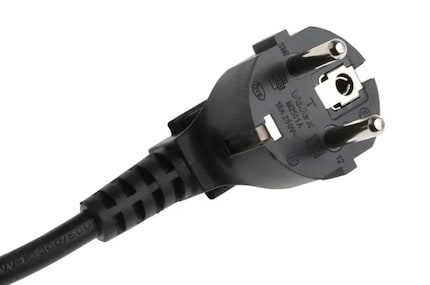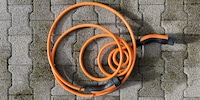

Handy when visiting friends: the Mobility Dock charges electric cars in tricky places
Although electricity’s universal, we can’t yet say the same for e-car charging stations. With the Lapp Mobility Dock, you can charge an electric car anywhere there’s a conventional power outlet. It’s pretty handy.
I drive an electric car. A fully electric one, not a hybrid. The latter are often only good for car manufacturers’ climate reports, not for the environment. Relying purely on an electric drive, however, means I need to have good charging infrastructure at my disposal. At home, that’s easy enough – I have a wallbox in my garage.
My car’s navigation system helps pinpoint charging stations when I’m on the road, and these days, there are dozens of apps that do the same. The thing is, getting to a public charging station is always time-consuming. They’re only rarely located next to nice cafés where I could kill time in a productive, pleasant way. Whenever I visit friends or family who don’t yet drive e-cars, I need to make sure the battery has enough juice for the journey home. Or, if we’re going on a longer drive, I need to allow time for a charging stop on the way.
Charge at any socket
I had a very specific use in mind when I ordered the Lapp Mobility Dock on Galaxus. Namely, the roughly 450-kilometre drive to visit our family. My Skoda Enyaq manages this with one or two charging stops, depending on the weather, my speed and power consumption on the motorway. To save time, we schedule these stops so that we arrive at our destination with a fairly low battery. We park in the driveway in front of the garage, where there’s a power outlet, but no wallbox. Cue the Mobility Dock!
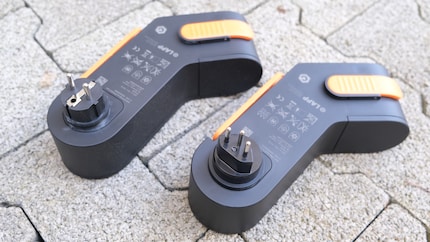
Source: Martin Jungfer
The gadget is about the size of a skilfully farmed aubergine – just under 30 centimetres long, 8 centimetres wide and 6 centimetres high. It fits snugly in your hand, and weighs a little over 700 grammes. Easy to fit into any e-car. If you’re a stickler for tidiness and style, you could also treat yourself to a foam-lined case where the Mobility Dock can be gently tucked away. You could also go for a bag or neoprene cover.



Lapp Mobility Neoprene sleeve for the Mobility Dock charger
One end of the Mobility Dock is fitted with a mains plug. There’s a version for Swiss type J sockets (one with three pins) and a version for EU sockets (CEE 7/3, type F). Unfortunately, you can’t simply swap out the Mobility Dock’s plug and use it in both Switzerland and the EU. If you want to power up at Granny’s in Graubünden and then again at Uncle Frank’s in Frankfurt, you’ll unfortunately need two devices.
You’ll obviously need a charging cable with a type 2 plug, i.e. the standard charging cable for an electric car, too. This is plugged into the Mobility Dock and connected to the car’s charging slot.
Instructions for proper use
Okay, that subheading sounds like it’s come right out of an instruction manual. And so it should. After all, there are a few things you have to bear in mind when charging a car from a standard household power outlet. Of course, these sockets don’t provide as much electricity as wallbox ones, which deliver 11 kilowatts or in some cases even 22 kilowatts. The Mobility Dock offers a maximum charging power of 2.3 kW in the EU version and 1.8 kW in the CH version.
To avoid damaging the power outlet, Lapp provides a wall bracket with each device. After all, when the Mobility Dock’s plugged in, the socket’s burdened by 700 grammes of weight, plus the pulling force of the cable.
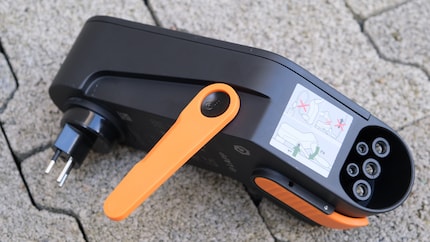
You should also only ever use the Mobility Dock «solo». Extension cables are not an option because they usually aren’t adequately fused. Thanks to IP55 protection, using outdoor sockets in the rain isn’t out of the question. Nevertheless, solutions offering water protection are better. You can forget the idea of using an adapter plug. Not only that, but you shouldn’t put the Mobility Dock on the ground while the car is charging.
Green, yellow, blue, red, white – charging status displayed in many colours
When it comes to the LED for displaying charging status, green is (as is so often the case) the colour of choice. On the Mobility Dock, a steady green light means the e-car is hooked up to the socket correctly. If the light flashes green, this means electricity’s flowing and the car’s charging. After you’ve plugged it in, it only takes a few seconds for the charging process to kick in.
The current might be reduced if you’re charging for longer or in high temperatures. When this happens, the LED indicator flashes blue.
And, of course, there’s also steady red and flashing red lights. As you’ve probably guessed, this tells you something’s up. If the device gets too hot, it switches off. The same thing happens if, in a fit of creativity, you’ve plugged the Mobility Dock into the socket upside down. This will also cause it to flash red, giving you a chance to realise your mistake and plug the device in correctly.
The Mobility Dock contains a position sensor that detects whether it’s been plugged into the socket correctly, i.e. cable down. While this isn’t an issue in «Schuko countries», you’ll need to be careful in Switzerland. As three-pronged sockets are widespread there, you’ll have to choose a socket where the Dock can be positioned as straight as possible when plugged in.
How fast does the Mobility Dock charge your car?
The Dock doesn’t have an indicator that displays charging speed. You’ll either need to check the display in the car or look at the app to see how much electricity is currently flowing, how long the car has left to charge or the volume of electricity being delivered as range per hour. The software provides different information depending on the car manufacturer.
During my test, I positioned a Mystrom smart plug between the socket and the Mobilty Dock. This allowed me to measure exactly how much power was being transferred from the socket to the car, without having to get into the vehicle to check the display. However, as I already covered in my instructions for proper use, that obviously isn’t a long-term solution.
Swiss version’s charging power almost as good as the specs say
In theory, power outlets in Switzerland can handle up to 2,300 watts. Lapp specifies a maximum output of 1,800 watts for the Mobility Dock. During my tests, I get a maximum of 1,200 watts for a Volkswagen e-Up. That’s just under 70 per cent of the promised performance.
When charging a more recent model of e-car, the Skoda Enyaq, the Mystom plug measures just under 1,700 watts, which is close to the figure outlined in the specs. Using the Dock over several hours isn’t a problem either, as the output remains constant.
EU version’s charging performance is slightly better
In Germany, where I also tested the Mobility Dock, the discrepancy between the promised and actual charging performance is slightly greater. There, the Enyaq charges at 1,900 watts from the garage socket – well over 80 per cent of the specified maximum output of 2,300 watts. And slightly more than in Switzerland. Unfortunately, I didn’t get a chance to see how well the older e-Up would do when plugged into a German socket. If you have any experience of this, please let me know in the comments.
Charging for long journeys takes time
Earlier on, I described some possible use cases for the Mobility Dock. Using the device, you can charge your e-car’s battery with between 1.2 kWh and 1.9 kWh per hour. You won’t be able to cover long distances at this amount of electricity. To be specific, it’d equate to about ten kilometres. With this in mind, it isn’t really worth plugging the Mobility Dock into a household socket if you’re just popping over to a friend’s place for a quick coffee. It’s more suited to overnight visits, when the battery would have time to reach a range of 100 kilometres or more.
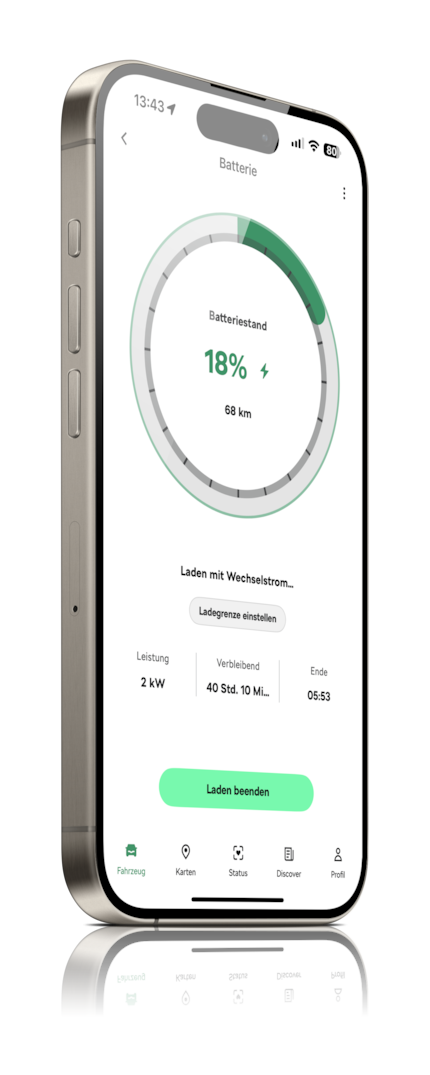
Source: Screenshot Skoda app
Juice Booster as an alternative?
The Lapp Mobility Dock does the job in many different scenarios. You can find a power outlet pretty much anywhere, whether it’s at a holiday home, a campsite or in a friend’s garage. As long as they’re okay with your e-car getting juice from their socket, you’ll be able to power up your battery with a few extra kWh. Alternatively, you could get a Juice Booster mobile charging station. That way, you’d get the charging unit (including display) and a cable in one bag – and it’d work with adapters too. However, at just under 700 francs, it’s also significantly more expensive.



Juice Technology Juice Booster Adapter household plug
CEE 7/7, 3 kW, 13 A
Manufacturers such as Deltaco, Green Cell and Digitus are pursuing a similar concept to the Lapp Mobility Dock with these cables. On these designs, the plug for the socket can’t be removed from the charging cable. Although these models are cheaper, you do lose some flexibility.
The Deltaco and Green Cell versions are even IP66-certified, meaning they can be used in pouring rain without any issues. Sometimes referred to as emergency cables, they’re a good alternative if you don’t yet have a second charging cable and know you’ll only be using one type of socket.
In a nutshell
Practical solution when visiting friends and family
Pro
- straightforward LED status indicators
- nifty wall bracket
- compact design, easy to fit in the car
- can be used with the charging cable you already have
Contra
- more expensive than an «emergency cable»
- plug is non-removable, so you can’t swap between an EU plug and a Swiss J-plug
- slower charging than with a regular wallbox
Journalist since 1997. Stopovers in Franconia (or the Franken region), Lake Constance, Obwalden, Nidwalden and Zurich. Father since 2014. Expert in editorial organisation and motivation. Focus on sustainability, home office tools, beautiful things for the home, creative toys and sports equipment.
